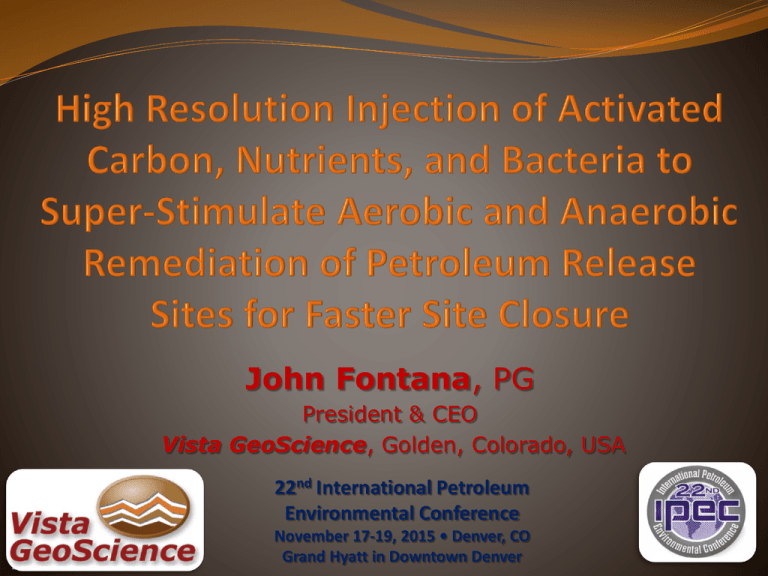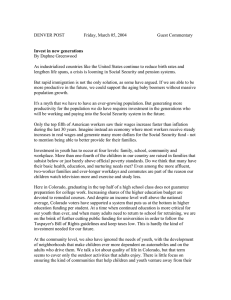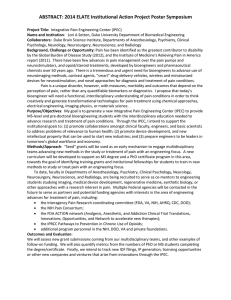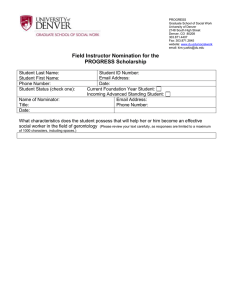John Fontana President & CEO Vista GeoScience 22
advertisement

John Fontana, PG President & CEO Vista GeoScience, Golden, Colorado, USA 22nd International Petroleum Environmental Conference November 17-19, 2015 • Denver, CO Grand Hyatt in Downtown Denver 1 Outline Data Needed to Design a Treatment Remedial Design Characterization (RDC) Tools 3-D Qualitative and Quantitative Data Activated Carbon+ (Specifically RPI BOS200®) Specialized Tools for Highly Targeted Injections Why the “Old Methods” Don’t Work The Right Tools and Methods Recent Examples Summary & Conclusion IPEC, Denver, Colorado, November 17-19, 2015 2 Why In-Situ Injections Limited or No Disposal Issues In Place Destruction of Contaminants Less Invasive - Works Around Infrastructure Many Work with Natural Environment Direct Push Injection Advancements Improved Understanding of Hydraulic-Fracturing Improved Monitoring Methods, So….. Seen as Faster, Cheaper and it’s…… Greener & Sustainable Technology! IPEC, Denver, Colorado, November 17-19, 2015 3 Site Closure from One Final Treatment Design The How: 1. Remedial Design Characterization (RDC): Collect both Qualitative and Quantitative High Resolution Data. 2. Pilot Testing 3. Apply the In-Situ Treatment: Use Precise Injection Designs, Adequate Pumps and Proper Tools. IPEC, Denver, Colorado, November 17-19, 2015 4 In-Situ Remediation: It’s a Contact Sport! HOME TEAM: Contaminated Soil & Ground Water VISITING TEAM: Treatment Reagents IPEC, Denver, Colorado, November 17-19, 2015 5 The Goals of a RDC Determine: Where the Contamination is Located Vertical and Horizontal Distribution How Much Mass is There to Treat (Dosing) Physical, Chemical & Biological Parameters as Needed for Specific Treatments. If Soil/Rock Types, Heterogeneity and Back Diffusion Affect the Choice of Methods IPEC, Denver, Colorado, November 17-19, 2015 6 Remedial Design Characterization - Critical for Success • But…Be MyBlindfolded Site is Already Characterized! Don’t and Miss the Target Yes, in 2-D, but we need more data for the Remedial Design! Most Important: 3-D Contaminant Distribution and Mass Lithologic & Hydrologic Parameters in greater detail Chemical Compatibility for certain treatments is unknown Natural Oxidant or Reductant Demand, e- Donors & Acceptors Geochemistry/Biochemistry – Bug Populations/Nutrients Errors result in significant under- or over-dosing – or both! A vertical and horizontal 3-D image of the site contaminant, geology and geochemistry is required! IPEC, Denver, Colorado, November 17-19, 2015 7 ISSUES: Adsorbed Phase vs. Dissolved Phase Contaminant Loading Soil and Ground Water Concentrations (ppm) 2.5 2 2 100 100 80 1.5 1 120 Contaminant Load by Volume (mg / ft3) 60 1 40 0.5 20 0 0 Ground Water Soil 8.5 Ground Water Soil If you design to only treat the dissolved phase contaminant, you get REBOUND IPEC, Denver, Colorado, November 17-19, 2015 8 Back Diffusion from Clays = REBOUND (Consider Mass Flux Discharge in RDC) Courtesy Tom Sale, PhD, Colorado State University (Go RAMS!) IPEC, Denver, Colorado, November 17-19, 2015 9 Direct Sensing Probing Tools MIP, HPT, LIF, EC, Cone Penetrometers, etc. High Resolution Sampling Methods Discrete Soil Core and Discrete Ground Water Sampling Determine the mass and distribution Other Investigation Tools/Methods IPEC, Denver, Colorado, November 17-19, 2015 10 High Resolution Direct Sensing Investigation Tools Membrane Interface Probe (MIP) at the Denver Federal Center IPEC, Denver, Colorado, November 17-19, 2015 11 High Resolution = Millions of Data Points MiHpt Log - Tracking SVOC DNAPL PPM 5,000 0 0.0 1.0 10,000 LAB RESULTS PID FID XSD 2.0 Pressure , Flow Est. K 3.0 4.0 5.0 Depth (m) 6.0 7.0 8.0 9.0 10.0 11.0 12.0 13.0 14.0 VOCs SVOCs Unknowns IPEC, Denver, Colorado, November 17-19, 2015 12 Laser Induced Fluorescence (LIF) Logs (Ultra Violet Optical Screening Tool – UVOST) IPEC, Denver, Colorado, November 17-19, 2015 13 • Dosing Calculations Required Contaminant Mass. • Continuous Cores Samples, Composite Samples • Discrete Ground Water Samples • Quantitative Lab Analysis of VOC, TPH, Nutrients • (Can be screening level data vs. definitive data.) IPEC, Denver, Colorado, November 17-19, 2015 14 Representative Sampling from Continuous Soil Cores (Remember: A saturated soil sample includes the pore water, and therefore the combined adsorbed and dissolved phase) Sub-Sampling Continuous Cores for VOCs Using Plugs Cutting a Composite “Wedge” from the Continuous Core ITRC (Interstate Technology & Regulatory Council). 2012. Incremental Sampling Methodology. ISM-1. www.itrcweb.org. IPEC, Denver, Colorado, November 17-19, 2015 15 Tools for Discrete Ground Water Samples Discrete GW Sampling Tools Multiple Wells with Discrete Screens Single Well with Multi-Level Ports ….BUT REMEMBER: 80-90% of the mass resides in the saturated soils. Geoprobe® Screen-Point Sampler Practical Handbook of Environmental Site Characterization and Ground-Water Monitoring, Second Edition, Ed. David M. Nielsen – CH 11, Multi-Level Ground Water Monitoring, Murray Einarson IPEC, Denver, Colorado, November 17-19, 2015 16 Use High Resolution Data to Create “Decision Units” for Treatment Dosing Injection Depth Area A 500 sq. ft, 5 pts. Area B 1,500 sq. ft, 15 pts Area C 4,000 sq. ft. 40 pts. 10 lbs 25 lbs 10 lbs 40 lbs 40 lbs 25 lbs 25 lbs 25 lbs 25 lbs 10 lbs 10 lbs 10 lbs DEPTH 12’ 14’ 16’ 18’ 20’ 10 lbs 22’ IPEC, Denver, Colorado, November 17-19, 2015 17 • Carbon/Biological Based Product Made of: - Activated Carbon - Calcium Sulfate - Nitrate - Micro and Macro Nutrients • The Trap and Treat Mechanism: 1. The “Trap”: Activated carbon adsorbs hydrocarbons. 2. The “Treat”: In place biodegradation of the HC Powdered Activated Carbon “My Old Friend” (Tom Fox, CDLE-OPS, LUST-Line) Sourced from coal, wood, or nut shells. Activation process increases surface area by creating pores in a carbon matrix. One pound has ~100 acres surface area. Apparent density ~0.5 g/cc (30 lbs/cu ft). Absorbs 10-35% of its weight in hydrocarbons. Indefinite retention of contaminants. Inhalation hazard, but non-toxic if ingested. IPEC, Denver, Colorado, November 17-19, 2015 19 BOS 200® Inventor – Scott Noland, President - RPI Ideal environment for the biological process, where hydrocarbons are adsorbed on to BOS 200® particles made up of: Electron Acceptors: oxygen, nitrate, ammonia and sulfate Nutrients - phosphorus and nitrogen Aerobic and Anaerobic Blend of Microbes Initially, Aerobic but then Anaerobic (Oxidation to Sulfate Reduction) Mixing / Inoculation Mixing Some Chemistry Takes Place 1. Nitrogen and Phosphorus Two Main Requirements 2. Dissolution of Nutrients 3. PPT of Calcium Phosphate for Long-Term Source 4. Saturation with Oxygen Inoculation Providing Time for Organisms to Inhabit the Pore Structure Aerobic One of the Most Energetically Favorable Paths End Products = CO2 and Water Along the Way Catechols, Alcohols, Aldehydes, Ketones, and VFA’s are Produced. Anaerobic Denitrification NO3- NO2- NO N2O NH4 N2 Sulfate Reduction SO42- + HC CO2 + H2S + H2O Multivalent Metals (Fe, Mn, primarily) Fermentation C6H12O6 + 2ADP + 2 phosphate 2 Lactic Acid + 2 ATP (many paths: C3, C4, acetogenesis, mixed acid, etc) Methanogenesis C6H6 + H2O CH3COOH + H2 Blend of Microorganisms At Last Count Approx. 27 Organisms Byproducts Nearly Impossible to Predict One Bugs Waste Another’s Desert Sulfide Controlled by Oxidation Capable of Degrading BTEX, Ethers, Alcohols, 1,4-Dioxane, THF, and a host of other HC’s Greater Than the Sum of the Individuals The Bugs are Too Big Can Inhabit the Macro and Meso Pore Structure Larger Pores Primarily Used to Transport not Adsorb Bugs Prefer Surfaces – Attach and Create Biofilm Secrete Enzymes to Facilitate Food Intake LNAPL Pores Saturated with Water LNAPL is Hydrophobic Cannot Overcome Osmotic Pore Pressure to Displace Water Can Sorb to Surface Surface Diffusion Promotes Bioavailablity Kinetics of BOS 200 First Order Kinetics 1. Rate of Change of Concentration with Time is Proportional to the Concentration. 2. Ln(C/Co) = -kT Which Concentration is Important? GW – Soil – BOS 200 Rates of Degradation Can be Very High Detecting Activity Pre & Post Injection Sampling for Changes in: Anions VOCs (BTEX, TPH, Other HC) Gases (methane, CO2) Now we know where the contaminants are and how much is there, so now we need properly targeted & applied treatments. Old vs. New Application Methods Conventional Injections vs. Hydraulic Fracturing Methods IPEC, Denver, Colorado, November 17-19, 2015 29 The “Old” Ways: Bottom Up Injections Path of Least Resistance Less Porous & Permeable Soils Preferential Bedding Planes Fracturing May Occur Clayey Formation Coarsening Downward Sandy Formation IPEC, Denver, Colorado, November 17-19, 2015 30 SOLUTION: Improved Tools & Pump Methods Top-Down Injections Tools High Pressure, High Flow Straddle Packers Isolated Intervals IPEC, Denver, Colorado, November 17-19, 2015 31 SOLUTIONS: Improved Injection Methods Top Down Injections Lateral Inj. Ports or Packers High Pressure/Flow Precise Placement Clayey Formation Low Perm will Fracture Permeable Zones will Fluidize Sandy Formation = BETTER CONTACT! IPEC, Denver, Colorado, November 17-19, 2015 32 Radius of Influence (ROI) Calculations; (Displacement vs. Pore Flow) 10’ Injection Grid: Radius = r = 5’ Area = πr2 Vertical Treatment Interval = h = 2’ Assuming Effective Porosity ≈ 20% Volume conversion: 1 ft3 = 7.48 gallons Therefore: Volume = π(5’)2 x (2’) x (0.2) = 31.42 ft3 Pore volume = 31.42 x 7.48 = 235 gallons A 50 gallons injection = about 21% of pore volume. HOWEVER: ROI is more a function of what % of the formation fractures during injection (displacement) vs. pore space flow. Do a Pilot Test Injection Phase with Confirmation Cores. IPEC, Denver, Colorado, November 17-19, 2015 33 Triangular vs. Square Injection Grids (Surface View) Square Grid Triangular Grid IPEC, Denver, Colorado, November 17-19, 2015 34 Staggered Top-Down Injection Intervals IPEC, Denver, Colorado, November 17-19, 2015 35 Slurry (Powders & Solids) Specialized Mixing & Pumping Systems IPEC, Denver, Colorado, November 17-19, 2015 36 Post Injection Core Observations – Spacing Confirmation Samples Monitor Wells Before and After Injections Monitor Water Levels During Injections, Observe for Impacts Clean Out Impacted Wells Collect Valid Water Samples Post Injection Weekly to Monthly right after injections for 3 Months Quarterly Thereafter BETX, TPH, Selected Anions IPEC, Denver, Colorado, November 17-19, 2015 37 Detecting Activity Pre & Post Injection Sampling for Changes in: Anions VOCs (BTEX, TPH, Other HC) Gases (methane, CO2) CDLE-OPS Event No. 11494 Release Discovered During Tank System Removal, August 2011 2nd Tank System Removed July 26, 2012; No Release Detected. Co-Mingled with PCE Plume from Upgradient Dry Cleaner Site New 7-Eleven Store Built Over Part of Plume Prior to Remediation Relatively Deep (Groundwater at ~45’) Site Consultant: IPEC, Denver, Colorado, November 17-19, 2015 39 3400 York Street; Phases of Work Site Developer: “NOT WAITING,” New Building Going In Before Injections Started. Chosen Remedy: RPI BOS-200® (Activated Carbon, Nutrients, Bacteria Augmentation) The Plan: 1. 2. 3. 4. 5. RDC Sampling & Treatment Design Pilot Injection Test Conducted Near MW-1R, Former Tank Pit Area (May 2013) Full Scale Site Injection on Balance of Site (Nov. 2013) Post Injection Well Cleaning and Redevelopment Post Injection Sampling & Monitoring IPEC, Denver, Colorado, November 17-19, 2015 40 Overlay of New Building Plan on Former Gas Station Site Courtesy CGRS Inc. IPEC, Denver, Colorado, November 17-19, 2015 41 RDC Event 8 Continuous Soil Cores 5’ – 50’ in Treatment Area 56 soil samples collected at 2’ composite intervals. 5 Monitor Wells Sampled in Treatment Area. Analysis of 56 Soil & 5 Ground Water Samples: 8260 VOCs (BTEX, MTBE, TVPH, PCE & Daughters) Sulfate, Chloride, Nitrate, Nitrite, Acetate (waters only) Identified Shallow Vadose Contamination in Former Tank Pit Area. Courtesy CGRS Inc. IPEC, Denver, Colorado, November 17-19, 2015 42 Injection Design PILOT TEST: (May 2013) Area A: MW-1R, former tank pit/source area; 12 pts, 15lbs/ft. 40’-50’ Total 1,800 lbs BOS200 FULL SCALE: (Nov 2013) Area B1: 15pts, 10 lbs/ft, 40’-50’ Area B2: 16 pts, 7.5 lbs/ft, 40-50’ Area C: 42 pts, 5 lbs/ft, 40-50’ Total 4,650 lbs BOS200 Area C Area B New Building Area A Courtesy CGRS Inc. IPEC, Denver, Colorado, November 17-19, 2015 43 Source Well: Pilot Injection May 2013 Results (Benzene ppb) SOURCE: MW-1R: 310-688 ND (PCE: 3330 ND) Mid-Plume Well: Full Scale Inj. Nov 2013 MIDPLUME: MW-10/2: 8-60 ND-3 (PCE: 6270 1830) MW-11: 2-3 ND (PCE: 2710 11) MW-12: 5-12 ND-3 (PCE: 13900 12900) MW-13: 23-47 3-6 (PCE: 595 1080) NFA achieved in 2015 after 6 post injection monitoring events Off Site Compliance Well, No Treatment Courtesy CGRS Inc. IPEC, Denver, Colorado, November 17-19, 2015 44 Cost to Our Client (Labor & Materials) RDC Sampling $5,000 Pilot Test $16,000 Full Scale $57,000 TOTAL: $78,000 = Cost Effective Cleanup – The First Time!! IPEC, Denver, Colorado, November 17-19, 2015 45 Yes – LNAPL Too! Busy Truck Stop Pilot Test Removed NAPL @ MW-13B 3.0 Feet of Product to 0.01 Feet in 3 Months IPEC, Denver, Colorado, November 17-19, 2015 46 Summary In-Situ Treatment Success Rates are Significantly Improved by: Performing a RDC phase to create a 3-D CSM by utilizing: 3-D Imaging (Qualitative) High Resolution Sampling Tools (Quantitative) Advanced Targeting Injection Tools and Methods Design Using Decision Units -Targeted Dosing Understanding ROI and Hydraulic Fracturing Utilizing Pilot Testing, Performance Monitoring Tools, Monitoring Progress and Make Adjustments on the Fly. The Goal of Clean Up & Closure – The First Time Around! IPEC, Denver, Colorado, November 17-19, 2015 47 More Summary It’s a Contact Sport, AND A TEAM SPORT ! Geology, Hydrology, Chemistry, Biology Consultant + Driller + Installer + Supplier IPEC, Denver, Colorado, November 17-19, 2015 48 Questions? High Resolution Injections of Activated Carbon, Nutrients, and Bacteria to Super-Stimulate Aerobic and Anaerobic Remediation of Petroleum Release Sites for Faster Site Closure John Fontana, PG JFontana@VistaGeoScience.com 22nd International Petroleum Environmental Conference November 17-19, 2015 • Denver, CO Grand Hyatt in Downtown Denver 49




